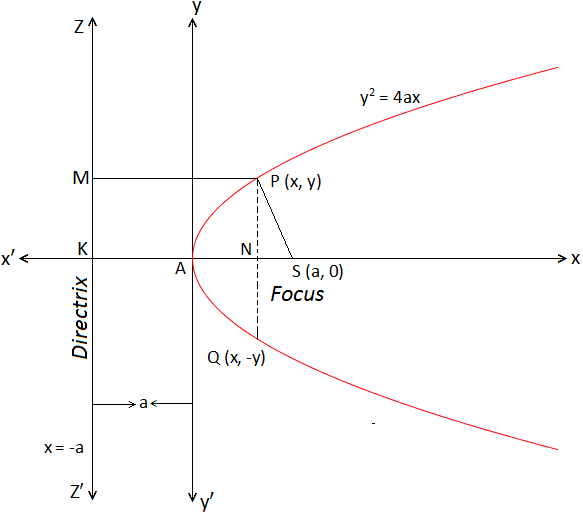Subscribe to our ▶️ YouTube channel 🔴 for the latest videos, updates, and tips.
Standard Equation of a Parabola
We will discuss about the standard equation of a parabola.
Let S be the focus and the straight line ZZ', the directrix of the required parabola. Let SK be the straight line through S perpendicular to the directrix, bisect SK at A and K being the point of intersection with the directrix.
Then
AS = AK
⇒ Distance of A from the focus = Distance of A from the directrix
⇒ A lies on the parabola
Let SK = 2a, where, a > 0.
Then AS = AK = a.
If this line SK intersects the parabola
at A then SK is the axis and A is the vertex of the
parabola. Draw the straight line AY through A
perpendicular to the axis. Now, we choose the origin of co-ordinates at A and x
and y-axis along AS and AY respectively.
Let P (x, y) be any point on the required parabola. Join SP and draw PM and PN perpendicular to the directrix ZZ' and x-axis. Then,
PM = NK = AN + AK = x + a
Now, P lies on the parabola ⇒ SP = PM
⇒ SP\(^{2}\) = PM\(^{2}\)
⇒ (x – a)\(^{2}\) + (y – 0)\(^{2}\) = (x + a)\(^{2}\)
⇒ y\(^{2}\) = 4ax, which is the required equation of the parabola. The equation of a parabola in the form y\(^{2}\) = 4ax is known as the standard equation of a parabola.
Notes:
(i) The parabola has two real foci situated on its axis one of which is the focus S and the other lies at infinity. The corresponding directrix is also at infinity.
(ii) The vertex of the parabola y\(^{2}\) = 4ax is at the origin i.e., the co-ordinates of its vertex are (0, 0).
(iii) The co-ordinates of the focus S of the parabola y\(^{2}\) = 4ax are (a, 0).
(iv) The axis of the parabola y\(^{2}\) = 4ax is positive x-axis (assuming a> 0).
(v) The parabola is
symmetric with respect to with respect to its axis. If the point P(x, y) lies on the parabola y\(^{2}\) = 4ax
with respect to x-axis, then the point Q (x, -y) also lies on it.
(vi) We have, y\(^{2}\) = 0 when x = 0; hence, the straight line x = 0 (i.e., y-axis) intersects the parabola y\(^{2}\) = 4ax at coincident points. Therefore, y-axis is a tangent to the parabola y\(^{2}\) = 4ax at the origin.
(vii) The line segment PQ is the double ordinate of P and PQ = 2y.
(viii) The co-ordinates of the end points of the latus rectum L\(_{1}\)L\(_{2}\) of the parabola y\(^{2}\) = 4ax are (a, 2a) and (a, -2a) respectively
(ix) The length of the latus rectum of the parabola y\(^{2}\) = 4ax is 4a.
(ix) The equation of the directrix of the parabola y\(^{2}\) = 4ax is x = - a ⇒ x + a = 0.
(x) The directrix of the parabola y\(^{2}\) = 4ax is parallel to y-axis and it passes through the point K (- a, 0).
(xi) x = at\(^{2}\), y = 2at is the parametric form of the parabola y\(^{2}\) = 4ax and t is called the parameter.
(xii) The co-ordinates of any point on the parabola y\(^{2}\) = 4ax can be represented as (at\(^{2}\), 2at) where (at\(^{2}\), 2at) are called the parametric co-ordinates of a point on the parabola y\(^{2}\) = 4ax.
(xiii) From the standard equation of the parabola y\(^{2}\) = 4ax we see that the value of y becomes imaginary when x < 0. Therefore, no portion of the parabola y\(^{2}\) = 4ax lies to the left of y-axis.
Again, if x is positive and gradually increases then y also increases and for each positive value of x we get two values of y which are equal and opposite in signs. Therefore, the curve extends to infinity on the right of the y-axis.
● The Parabola
- Concept of Parabola
- Standard Equation of a Parabola
- Standard form of Parabola y22 = - 4ax
- Standard form of Parabola x22 = 4ay
- Standard form of Parabola x22 = -4ay
- Parabola whose Vertex at a given Point and Axis is Parallel to x-axis
- Parabola whose Vertex at a given Point and Axis is Parallel to y-axis
- Position of a Point with respect to a Parabola
- Parametric Equations of a Parabola
- Parabola Formulae
- Problems on Parabola
11 and 12 Grade Math
From Standard Equation of a Parabola to HOME PAGE
Didn't find what you were looking for? Or want to know more information about Math Only Math. Use this Google Search to find what you need.



New! Comments
Have your say about what you just read! Leave me a comment in the box below. Ask a Question or Answer a Question.